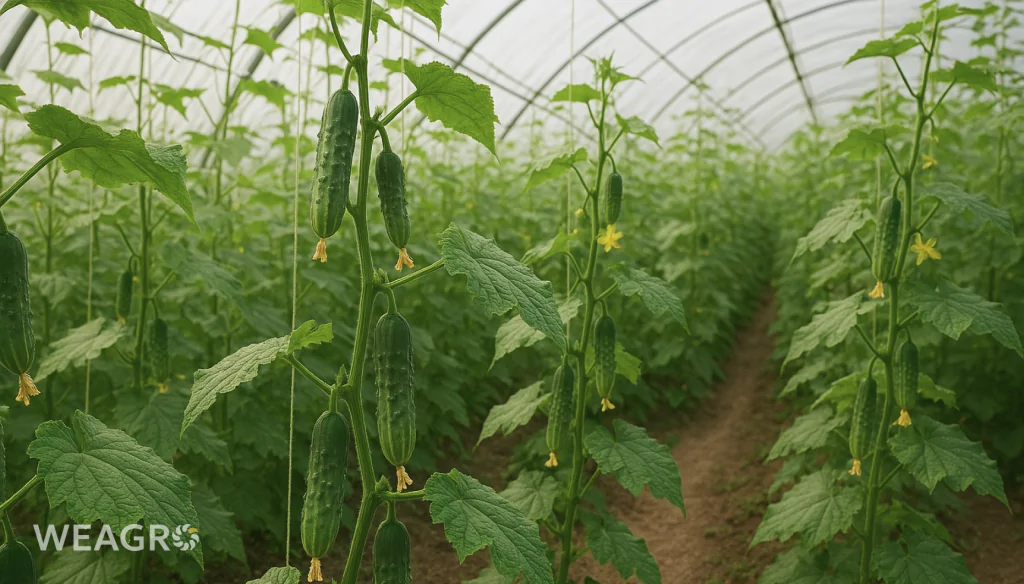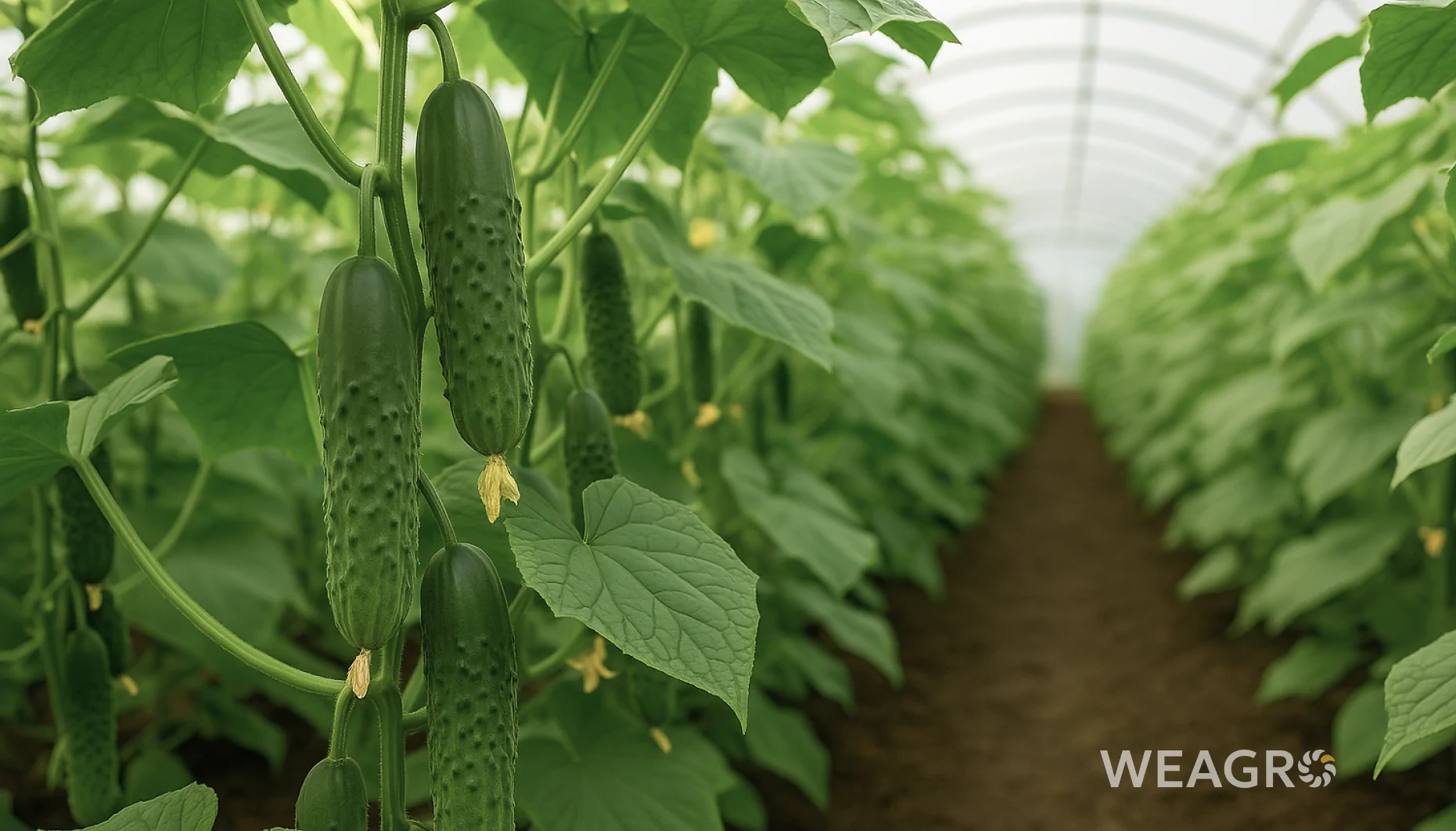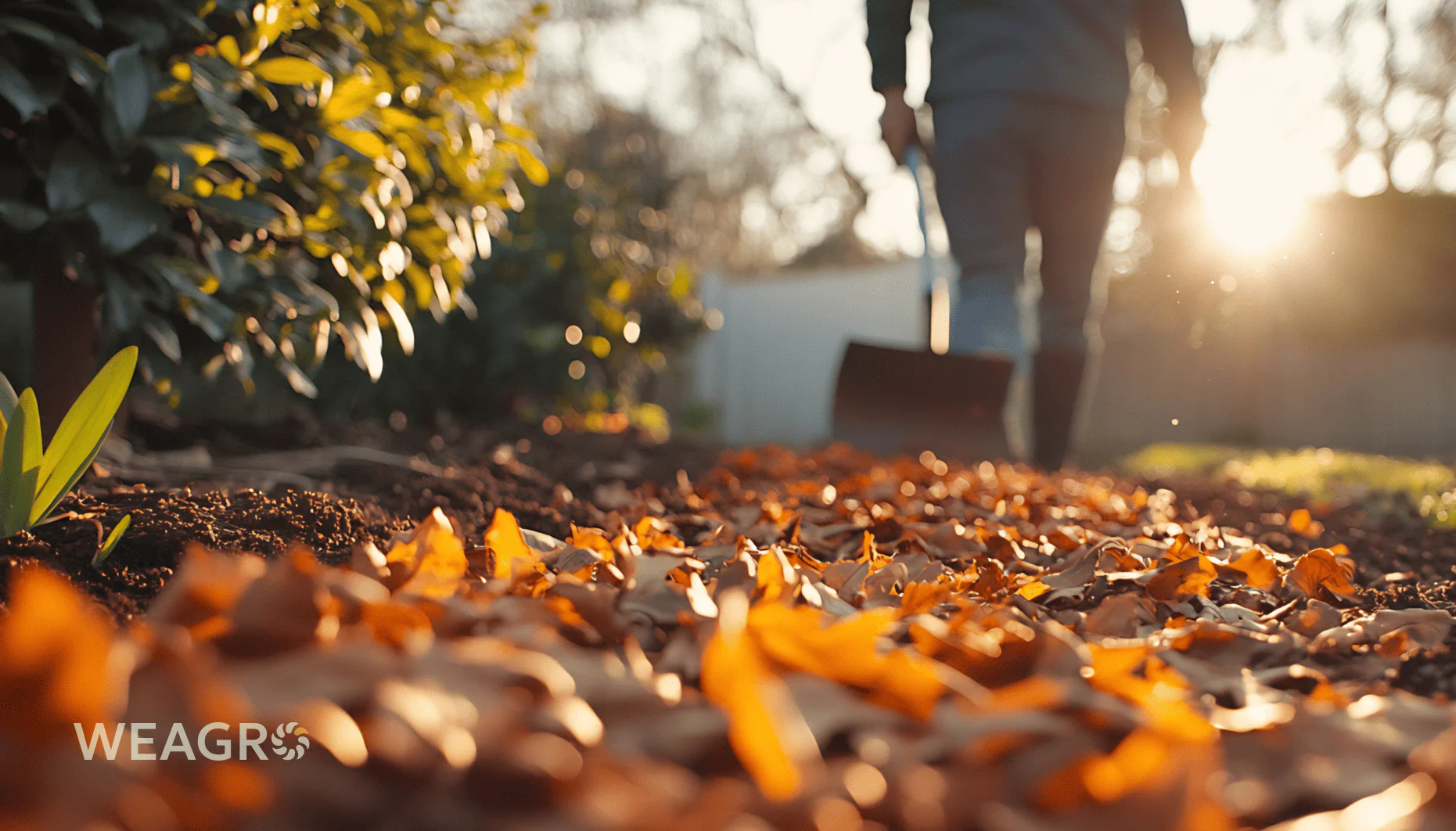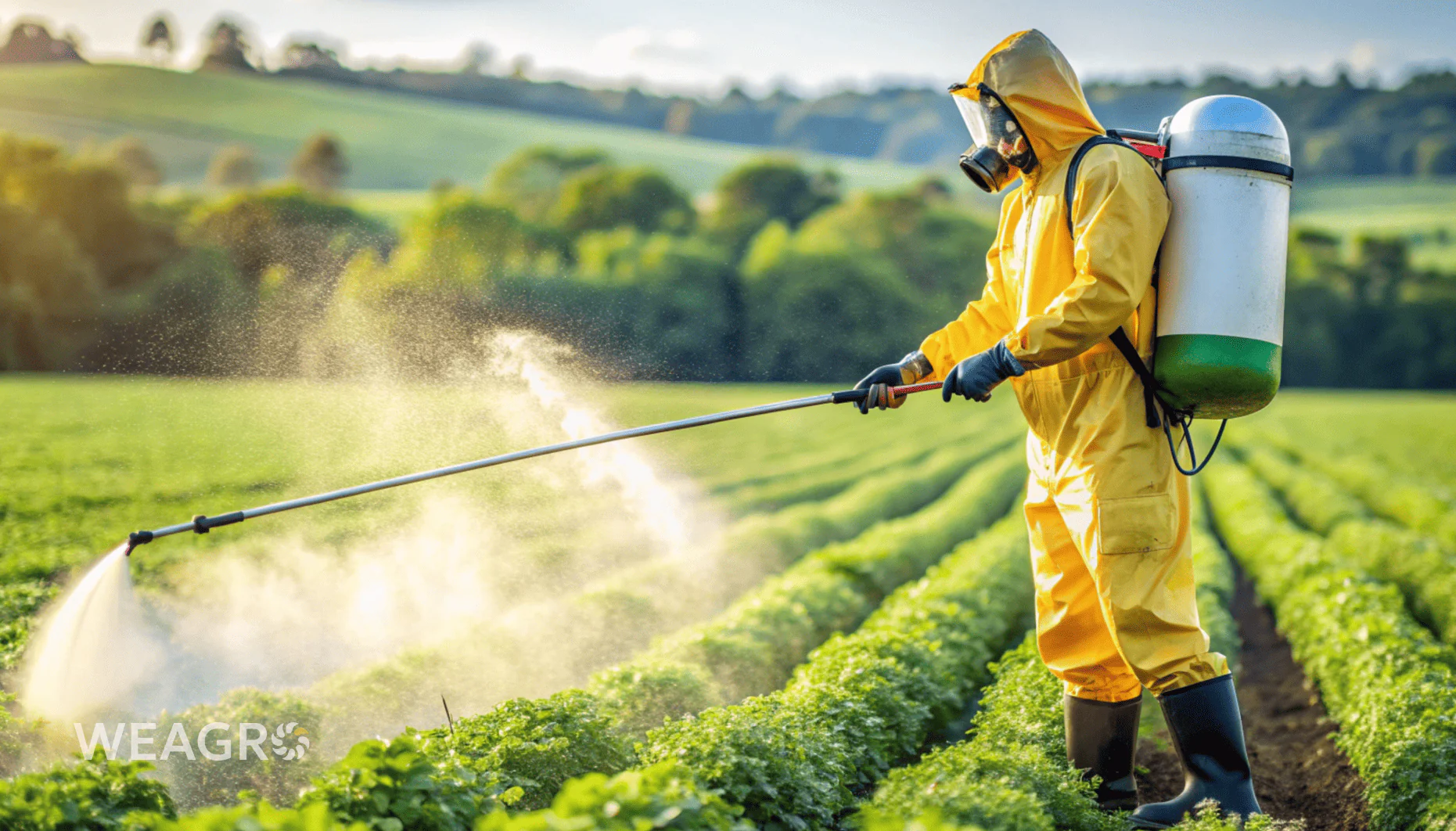Growing cucumbers in greenhouses is a popular and promising agricultural business direction in Ukraine. According to State Statistics, in 2023 the area of protected ground crops was 4.2 thousand hectares, with cucumber and gherkin production reaching 106.9 thousand tons. This article will be useful for farmers planning to start or improve greenhouse cultivation. We will examine greenhouse selection, soil preparation, varieties, cultivation technology, and discuss the main plant diseases and pests.
Which Greenhouses are Suitable for Growing Cucumbers
The following types of greenhouses are suitable for successful cucumber cultivation:
- Glass. Provides good light transmission but requires higher initial investment.
- Film. Budget option, covering needs replacement every 2-3 seasons.
- Polycarbonate. Optimal choice for price-to-durability ratio.
Several factors should be considered when choosing:
- Size and shape. Depend on production scale and available area. Most common: arch, gable, block.
- Ventilation and heating. Air supply and heating systems (boilers, heat generators, heated floors) are necessary for maintaining optimal microclimate.
- Operational convenience. The facility should be equipped with doors, passages, water supply, and drainage.
Additionally, when planning, space should be allocated for work areas, storage facilities, and other operational needs.
Read also: Greenhouses as a Business in the Agricultural Sector
Soil Preparation for Greenhouse Cucumbers
Greenhouse cucumbers prefer fertile, loose soil with neutral acidity (pH 6.5-7). In autumn, the soil is dug to a depth of 25-30 cm, with humus or compost added (5-7 kg/m²). In spring, 2 weeks before planting seedlings, the soil is loosened and enriched with organic fertilizers such as:
- composted manure (3-4 kg/m²);
- biohumus (1-2 kg/m²);
- wood ash (100-150 g/m²);
- bone meal (80-100 g/m²).
The soil is leveled and formed into ridges or beds 90 cm wide and 25-30 cm high. Some farmers prefer growing on coconut substrate, which allows better control of plant nutrition and prevents soil-borne diseases. Before use, the base is soaked in organic fertilizer solution for 12 hours, then placed in trays or bags.
To avoid disease accumulation, it’s advisable to change the top layer of soil or substrate annually. Green manure crops (oil radish, mustard, lupine) should also be used to improve soil health and enrich it with organic matter.
Read also: Organic fertilizers: what they are, types and application rates
To improve soil fertility and structure, the following fertilizers are also recommended:
- humus or compost – 5-7 kg/m²;
- biohumus – 3-5 kg/m²;
- poultry manure – 1-2 kg/m².
Fresh manure is not recommended as it can cause nitrate accumulation in fruits and promote disease development.
Read also: Soil: What It Is, Types, and Its Fertility
Choosing Cucumber Varieties for Greenhouse

Self-pollinating hybrids or parthenocarpic varieties are suitable for greenhouse cucumber cultivation. Let’s look at some popular ones:
- Kurazh F1. Early parthenocarpic hybrid with strong vegetative growth, 38-43 days from sprouting to first harvest. Fruits are 11-14 cm long, without bitterness. Disease-resistant, self-pollinating.
- Amur. Early-maturing hybrid with a long central stem. Starts bearing fruit on day 37-40. Small cucumbers, gherkins length 8-12 cm. Doesn’t yellow or become bitter when ripening.
- Anyuta F1. Salad type variety. High yield – one square meter can produce 13-16 kg. Plants begin fruiting 35-45 days after sprouting. Resistant to cucumber mosaic, powdery mildew, and olive spotting.
- Marfinsky. One of the most shade-tolerant varieties, suitable for winter growing. Short fruits, ideal for salads. High yield: 29-32 kg per square meter possible. Relatively shade-tolerant, bee-pollinated.
- Ecole. Super-early Dutch hybrid. High-yielding, self-pollinating crop. Shade-tolerant. Fruits appear on days 42-45. Small bumpy cucumbers 8-10 cm long. Plant is resistant to most diseases.
- Connie F1. Resistant to powdery mildew, distinguished by good yield and high fruit quality.
When choosing a variety or hybrid for greenhouse cucumber cultivation, consider:
- maturation period – for conveyor production, it’s better to select varieties with different maturity times;
- pollination type – self-pollinating or parthenocarpic varieties don’t require additional insect pollination.
Disease resistance is also important – it helps reduce treatment costs and improve product marketability.
Greenhouse Cucumber Growing Technology
So, how to grow cucumbers in a greenhouse? The process includes several stages: seed sowing or seedling planting, plant formation, watering, and fertilizing. When should cucumbers be planted in the greenhouse? Seedlings are planted at 20-25 days old, when they have 3-4 true leaves.
When to Plant Greenhouse Cucumbers
The timing for planting greenhouse cucumber seedlings depends on the region and heating availability.
| Region | Variety | Seed Sowing Dates |
| Southern Ukraine | Early | February 10-15 |
| Medium | February 20-25 | |
| Northern and Central Ukraine | Early | February 20-25 |
| Medium | March 1-5 |
Seedlings are first placed in peat pots or 8×8 cm cassettes filled with nutrient substrate. Place drainage material (expanded clay) at the bottom, cover with sifted soil mix, and moisten with fungicide solution. Plant 1-2 seeds in each cell, 1-1.5 cm deep. Mulch the top with peat or agro-fabric.
Sprouts appear in 3-5 days at substrate temperature of 25°C. After sprouting, temperature is reduced to 18-20°C during day and 15-17°C at night. Relative air humidity should be 80-85%.
Start hardening seedlings 5-7 days before greenhouse planting. Take them outdoors to a wind-protected area and gradually increase outdoor exposure time.
Planting Distance for Greenhouse Cucumbers
Seedling planting scheme:
- row spacing – 70-90 cm;
- plant spacing within row – 25-30 cm;
- planting density – 3-4 plants per 1 m².
Some farmers practice dense planting with 15-20 cm between plants. This increases yield per unit area but requires more careful maintenance.
For convenience, stems are planted in a checkerboard pattern. It’s recommended to alternate early and medium-maturing varieties to extend the fruiting period.
How to Plant Greenhouse Cucumbers

Here’s how to properly plant cucumbers in a greenhouse:
- Prepare holes 10-12 cm deep according to the planting scheme.
- Water the holes with warm water (20-22°C).
- Carefully remove seedlings from pots, trying not to damage the root ball.
- Place seedlings in holes and cover with soil up to the cotyledon leaves.
- Compact soil around plants and water with warm water.
After planting, shade the crop from direct sunlight using agro-fabric or nets. Remove shading when plants establish and begin active growth.
10-12 days after planting seedlings, add soil around plants to promote additional root formation. Gradually tie stems to trellises using soft twine or clips.
Greenhouse Cucumber Care
Main care measures for greenhouse cucumbers:
- watering – regular drip irrigation with warm water, maintaining soil moisture at 75-85%;
- greenhouse cucumber fertilization – first application two weeks after planting with organic complex fertilizer, then every 10-12 days, alternating different types of organic fertilizers;
- plant formation – removing side shoots up to 4-5 leaves, pinching tops above 3-4 leaves;
- disease and pest prevention – regular treatment with biological preparations according to instructions.
Drip irrigation with simultaneous fertilizer application – fertigation – is used for watering and feeding. This optimizes expenses and evenly distributes them throughout vegetation. Watering rate is 3-5 L/m² per day.
What to Feed Greenhouse Cucumbers for Balanced Nutrients?
| Development Phase | Nutrients | Organic Fertilizer |
| Vegetative | Nitrogen, Potassium | Cow manure infusion (1:10) |
| Flowering | Phosphorus, Potassium | Ash infusion (200g per 10L water) |
| Fruiting | Phosphorus, Potassium, Calcium | Compost tea + bone meal |
For chlorosis prevention, foliar feeding with organic solutions rich in magnesium and microelements is recommended, such as nettle infusion, seaweed solution, organic compost tea, or vermicompost extract.
Vertical and horizontal trellis growing methods are used for plant formation. In vertical growing, the main stem is twisted around twine with regular pinching of side shoots and tendrils. In horizontal growing, stems are tied to trellises at 1.8-2 m height.
Greenhouse Cucumber Yield
Following proper growing technology, yields are:
- in spring greenhouses – 12-14 kg/m²;
- in winter greenhouses with supplemental lighting – 35-40 kg/m².
To achieve high yields, it’s important to ensure optimal conditions for plant growth and development throughout the vegetation period:
- Air temperature. 23-26°C during day, 18-20°C at night.
- Relative air humidity. 75-85%.
- Light intensity. 10-12 thousand lux.
- CO2 content. 800-1200 ppm.
Increasing carbon dioxide concentration to 1000-1500 ppm using gas generators can increase yield by 30-40%.
For yield improvement, timely purchase of quality materials is crucial. The WEAGRO service allows farmers to buy necessary resources with deferred payment without collateral and additional documents. This approach helps farms invest in quality seeds and modern growing technologies, significantly improving final yield indicators.
Harvesting and Storage of Cucumbers
Besides knowing how to grow greenhouse cucumbers, it’s important to understand harvesting methods. Harvesting begins 40-50 days after planting seedlings, depending on variety. Cucumbers are harvested 3-4 times per week, avoiding overripening. Fruits should have a pronounced glossy surface, be firm, and show no signs of yellowing.
For storage, select vegetables with 1-2 cm stems, undamaged by diseases and pests. Store at 7-10°C and 95-98% air humidity for 10-12 days.
To extend shelf life, treat fruits with ethylene solution (1-2 µl/L) or pack in perforated polyethylene bags.
Greenhouse Cucumber Diseases
Main greenhouse cucumber diseases:
- Powdery mildew. Fungal disease appearing as white coating on leaves and stems. For prevention, optimal temperature should be 22-26°C, and air humidity 70-80%. Bacterial preparation treatment is necessary.
- Downy mildew. Forms yellow-brown spots on leaves, stems wilt. Prevention requires crop rotation, moderate watering, biofungicide treatment.
- Anthracnose. Light yellow spots form on leaves and fruits, stems dry up. Important prevention measures include varietal resistance, fungicide treatments, collection and destruction of affected fruits.
- Root rot. Plant yellows and wilts. Seed treatment with microbiological preparations, soil disinfection, and moderate watering are necessary.
- Bacteriosis. Oily spots of irregular shape appear on leaves, later becoming necrotic. Using healthy seeds, destroying plant residues, and treating with biological preparations are effective.
Both agrotechnical measures and biological preparations based on beneficial microorganisms are used to combat and prevent diseases in greenhouse cucumber cultivation.
Greenhouse Cucumber Pests
Most common greenhouse cucumber pests:
- Spider mite. Sucks sap from leaves, causing yellowing and drying. Treatment with garlic, onion, or tobacco infusions and use of predatory mites are needed.
- Aphids. Feed on leaf sap, causing deformation. Recommended treatments include tobacco, garlic infusions or soap solutions, and use of entomophages.
- Thrips. Attack leaves and buds, cause ovary drop, transmit viral diseases. Sticky traps and natural insecticide treatments help control them.
- Whitefly. Larvae suck sap from leaves, covering them with sticky secretions where sooty mold develops. Yellow sticky traps are used, along with regular collection and destruction of infected leaves and biological preparations.
Colored sticky traps are used to monitor pest populations. Yellow traps attract aphids, whiteflies, and thrips, while blue ones attract thrips and leaf-mining flies.
Biological pest control methods involve using their natural enemies – predatory insects and mites. Most effective entomophages:
- predatory mites of Phytoseiulus and Amblyseius genera – destroy spider mites;
- aphidius – parasitic wasp that lays eggs in aphid bodies;
- encarsia – whitefly endoparasite;
- orius – predatory bug that feeds on thrips, aphids, and mites.
Using biological preparations and entomophages helps reduce pesticide load and obtain environmentally safe greenhouse cucumber production.
Conclusion
Growing cucumbers in greenhouses is a promising direction for Ukrainian agricultural producers. A professional approach, from choosing covering type and varieties to regular care and disease and pest control, enables consistently high yields. Thanks to precision farming technology development, digitalization, and innovative solutions, it’s now possible to effectively monitor plant condition, microclimate, and prevent problems. All this contributes to increasing greenhouse business profitability in Ukraine.
The key to successful cultivation is proper planning and strict control of all stages. And our modern online service WEAGRO helps farmers purchase necessary material and technical resources in installments without collateral and excess documentation. This is a convenient financial tool that supports agricultural producers in achieving high results.









